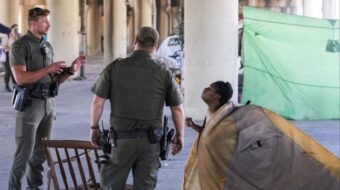
LOS ANGELES—The last time I encountered Roger Q. Mason was with their play Lavender Men, a fanciful yet, I believe, largely fact-based in-depth look at Abraham Lincoln’s intimate life. It’s now been turned into a film that, from the trailer, looks based on the stage production. Once you see it, you may become convinced that America has already had its first queer president (though his immediate predecessor in the White House, James Buchanan, might equally qualify for that distinction).
Now the award-winning playwright has come up with a trilogy of plays about California—or Califas in the Latin imagination. The first, California Story (seen opening night, May 12), addresses the legacy of Pío Pico (1801-1894), Alta California’s last Mexican governor, an Afro-Indigenous-Hispanic Mexican man after whom L.A.’s long Pico Boulevard is named, as well as the city of Pico Rivera, and other sites such as schools and libraries. (The name Pío is Spanish for “pious”—or Pius in Latin, the name of many popes.)
Pío Pico (Peter Mendoza) had a storied though problematic career. Mason explores him in a contemporary way (as only a queer non-binary artist could) as a multiracial figure who fought for identity and survival as he continued to pursue power in a world ever more dominated by Anglo influences, especially after the U.S. took California in the wake of the 1846-48 Mexican-American War that immediately followed the U.S. annexation of Texas in 1845. Mason centers issues such as race, gender, privilege, ambition, land use, and ecology in their epic, mostly 19th-century tale that has afterthoughts extending all the way to a dystopian 2051. The theme of water, an ever-present concern in the state, is a constant throughout—how to harness it, conserve it, market it. A projection screen that announces scene numbers and names greets the audience on arrival in the theater with the show title and its description as “A Faustian Preter-Capitalist Scream.”
Is capitalism, then, a Faustian pact (with the Devil, i.e., self-destruction) that we experience here in its formational (preter) stages and will eventually leave us all screaming? I think that’s what Mason is saying, and it’s what I heard: I am human, hear me scream!
If what we have now is capitalism, then what is the “preter” stage Mason refers to? It helps to review a little more history to discuss this play. On opening night, we had a welcome and blessing from Candido Cornejo, in both English and the Tongva language, one among the many spoken by the Indigenous peoples of what we refer to now as California. So that establishes that the story does not begin with the Spanish conquistadors. The Catholic missionaries established their outposts all up the state, herding the local populace, with the assistance of the genocidal military, into compounds perhaps better called concentration camps, where they learned Western farming, animal breeding, metalwork, construction, modest Western clothes, and religion. The Spanish monarchy rewarded loyal conquistadors and officials with land grants. Both the missions and the land grants were intended to “civilize” and populate the vast territories Spain controlled, even as the Native numbers severely declined owing to disease, conquest, and forced assimilation.

Pío Pico, a military man and later a member of the colonial governing assembly, received his first land grant in 1829—8922 acres near San Diego, named Rancho Jamul. Twelve years later, in 1841, Pico and his younger brother Andrés (Davi Santos) received another grant of 133,441 acres, called Rancho Santa Margarita, in what is today Orange County, south of L.A.
The problem with the land grants is that, as favors from the royal house, the owners had little incentive to “improve” the land (of course, the Natives did not necessarily regard Western development as “improvement”). So much of it lay fallow, a source of pride and pleasure for Pío, who stood on it knowing he owned everything he could see for miles around. His imitation of an eagle call elicited a screeching response from the eagles themselves, proving how integral he felt with the land. Over time, Pío became wealthy, not only in land holding, which he bought (with borrowed money) more and more of, but in urban projects as well. He owned and often resided in a hotel he established in the town of Los Angeles. The Pico Building still stands as an elegant testament to his stature as a citizen of Alta California (as distinguished from Baja California).
Pico’s relationship to the land was preter-capitalist, to use Mason’s terminology, a remnant, one could say, of European feudalism. These large landholdings became, throughout Latin America, what are called “latifundia,” often the home of sharecroppers barely scraping by on what the patrón allowed them to keep, and sometimes even containing little villages surrounding stores where they could purchase (to the patrón’s profit, naturally) daily necessities. The North American versions of such communities were the infamous company towns in coal, copper, oil, textile, farming, and other industries.
But with the incursion of the gold- and riches-seeking Anglos from the east, and even from abroad, the land assumed a different character. After all, from the Atlantic shores ever westward, they had appropriated Native territory at will to turn it into sustainable and often profitable homesteads and croplands.
The Anglo presence in the play comes in the persona of John Forster (Sawyer Shine), originally an indentured servant from Liverpool, whose Manifest Destiny dreams lead him west to acquire land and monetize it. Pío marries off his sister Isadora (Camila Arteche) to John to join their fortunes. Over time, with his acquisition of more land just for the sake of owning it, but failure at making it productive, even resistance to sell off parts of it, Pío goes bankrupt, and John assumes the upper hand. All of this is played out on the stage. Curiously, Shine also plays White Man dressed in funky Native chieftain garb—a feathery cloak and a crown made of soda straws. One connection between these two characters is that they both oppose Pío’s model—one because Pío is obsessed with hoarding the land, and the other because Pío does nothing to improve the land he hoards.
Playwright Mason has ambitious hopes. “My goal for the Califas Trilogy is to bring Los Angeles together as a community,” they say. “Our city has often been divided by social disparities, real estate interests, and culture wars aimed at dividing rather than uniting us. The L.A. of my youth was essentially a collection of suburbs in search of a true center. But that is not its present and cannot be its future. The recent fires have highlighted our need to come together and transcend our differences in finance, geography, privilege, and access. Califas Trilogy is an invitation for Los Angeles to embark on a new journey of unity through the exploration offered in these works of performance.”
The four named characters in the play, often making their exits and entrances on scooters, are balanced out—overshadowed in many scenes—by a triad of voguing muses, a Greek chorus known as the Legendary Children (though they are fully grown adults): Morgan Danielle Day (Child #1), Gracie Cartier (Child # 2), and Aphrodite Armstrong (Child #3). Gaudily vulgar in gauze, glitter, and glamor, and fleet of foot on well-deployed roller skates, they constitute an inescapable presence in the lives of the three Pico siblings and John, as servants, observers, commentators, admonishers, hectors, with a contemporary argot that openly plays to the audience.
Perhaps I would be wise to defer to those who know this culture better than I do to judge how much of their shouted insults and tacky put-downs was justified or necessary, only saying that from a theatrical point of view where, generally speaking, everything in a play is purposefully employed to advance it, the sheer volume of their chatter significantly lengthened the play without, in my estimation, compensatory enlightenment.
Directed by Michael Alvarez, a longtime collaborator with the author (as is Producing Artistic Director Jessica Hanna), the colorful, exuberant world premiere production at the Caminito Theater at Los Angeles City College runs through June 3. In some ways, the play is a homecoming: “Not a lot of people know this,” Mason says, recalling coursework they took 25 years ago, “but I began my collegiate education at LACC, taking classes from professors Melville Aaron (sociology) and Luther Henderson III (ethnomusicology). These sage educators galvanized my interest in making art that used multi-disciplinary storytelling practices to investigate the history and heart of our country through playwriting.”
In a statement, director Alvarez writes, “It is my hope that this tale prompts a deep reflection in audiences, encouraging them to consider their own life journey. What sacrifices, both conscious and unconscious, have they made to navigate and integrate into the world around them? What aspects of their true selves might have been compromised, lost, or silenced in their pursuit of progress and belonging? Ultimately, what price are we, as individuals and as a society, truly willing to pay for advancement?…
“It’s remarkable, and perhaps sobering, that over the ten years Roger and I have been envisioning and developing this work, its immediacy, relevance, and necessity have only grown more apparent. It seems that hardly a day passes without headlines that eerily mirror the core themes we explore within California Story. This confluence of art and life positions the piece as a powerful call for global healing and a renewed focus on our collective well-being, rather than solely on individual gain.”
A “preter-socialist” cry from the heart, perhaps?

After all is said and done, despite the extravagant incongruities of time and place, Mason manages to make their characters sympathetic, especially Andrés who always looked up to his older brother only to find he was a pitiable washout, and Isadora, who realizes how she had been used merely as a bargaining chip in Pío and John’s business arrangements. Even Pío, at the end, humiliated and penitent with everything gone, carries a humble basket of his fragrant lemons.
The production boasts an impressive creative team, including Salmah Beydoun (Scenic & Projections Design), Levi Manners (Sound Design), David Gonzalez (Composer), Noelle Rodriguez (Dialect Coach), Celina Lee Surniak (Intimacy Director), Joey Navarette-Medina (Choreographer), and Karen Boyer (Costume Design). Physically, the stage is often transformed into a vision of beauty, and not just when the three male actors remove all their clothes.
California Story is performed Mon., Tues., Fri., and Sat. at 7:30 pm, and Sun. at 3 pm (no show on Mon., May 19). The theater is located on the LACC campus, 855 N. Vermont Ave., Los Angeles 90028. Ample street parking is available in the area—recommended on Heliotrope Drive near the Administration Building. Tickets are available here. Talkbacks after the show will be held on Sun., May 18, and Sun., May 25, in-depth discussions with community leaders, educators, and artists. May 18 is BIPOC Day, focusing on representation, heritage, and how the arts contribute to cultural visibility and identity-building. May 25 is Queer Day, a dialogue exploring the importance of queer narratives within the arts, with a focus on intersectionality, community-building, and the ongoing fight for visibility and inclusion in storytelling spaces.
The Califas Trilogy is produced by Outside In Theatre and Skylight Theatre Company in association with Roots & Wings Project. Part two, Hide and Hide, will be presented May 9-June 22 at Skylight Theatre Company, and the final play, Juana Maria, will receive a staged reading at the LACC Caminito Theater on May 25 & June 1.
We hope you appreciated this article. At People’s World, we believe news and information should be free and accessible to all, but we need your help. Our journalism is free of corporate influence and paywalls because we are totally reader-supported. Only you, our readers and supporters, make this possible. If you enjoy reading People’s World and the stories we bring you, please support our work by donating or becoming a monthly sustainer today. Thank you!










